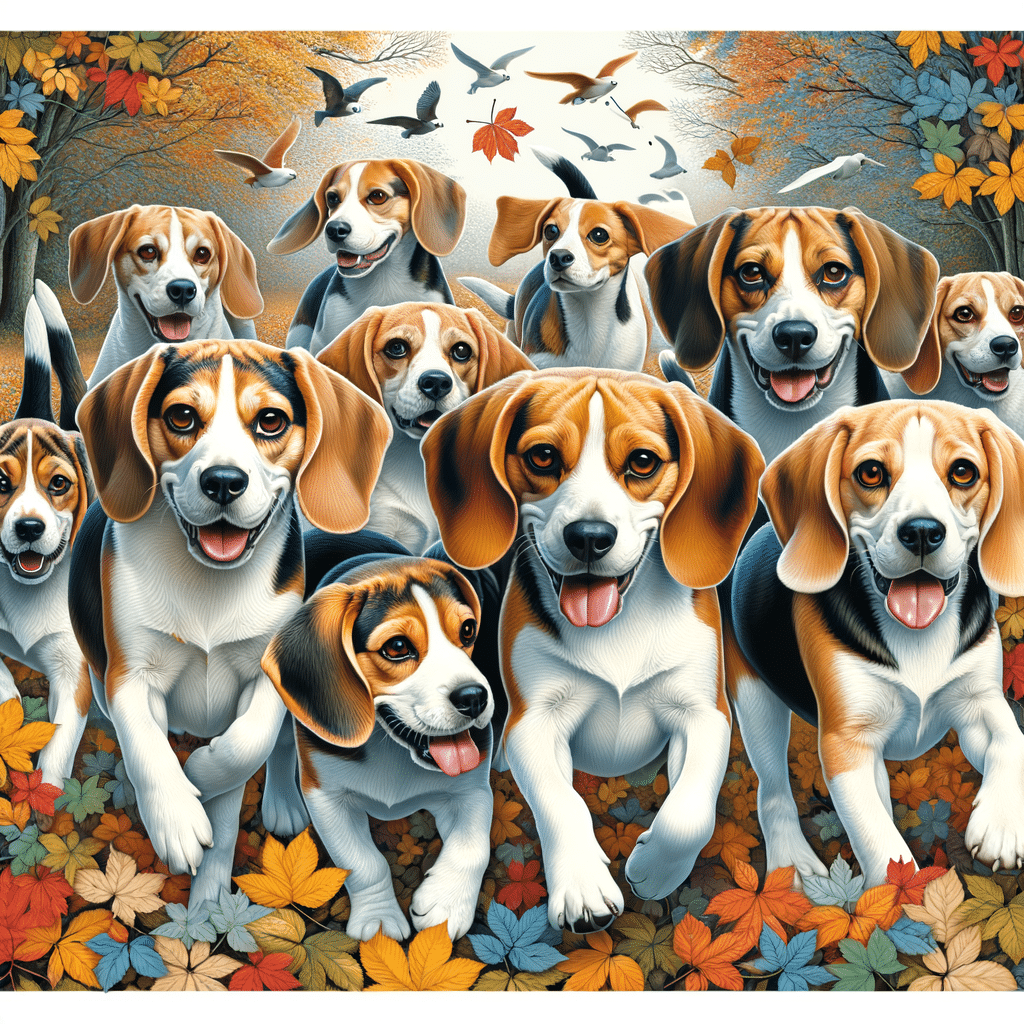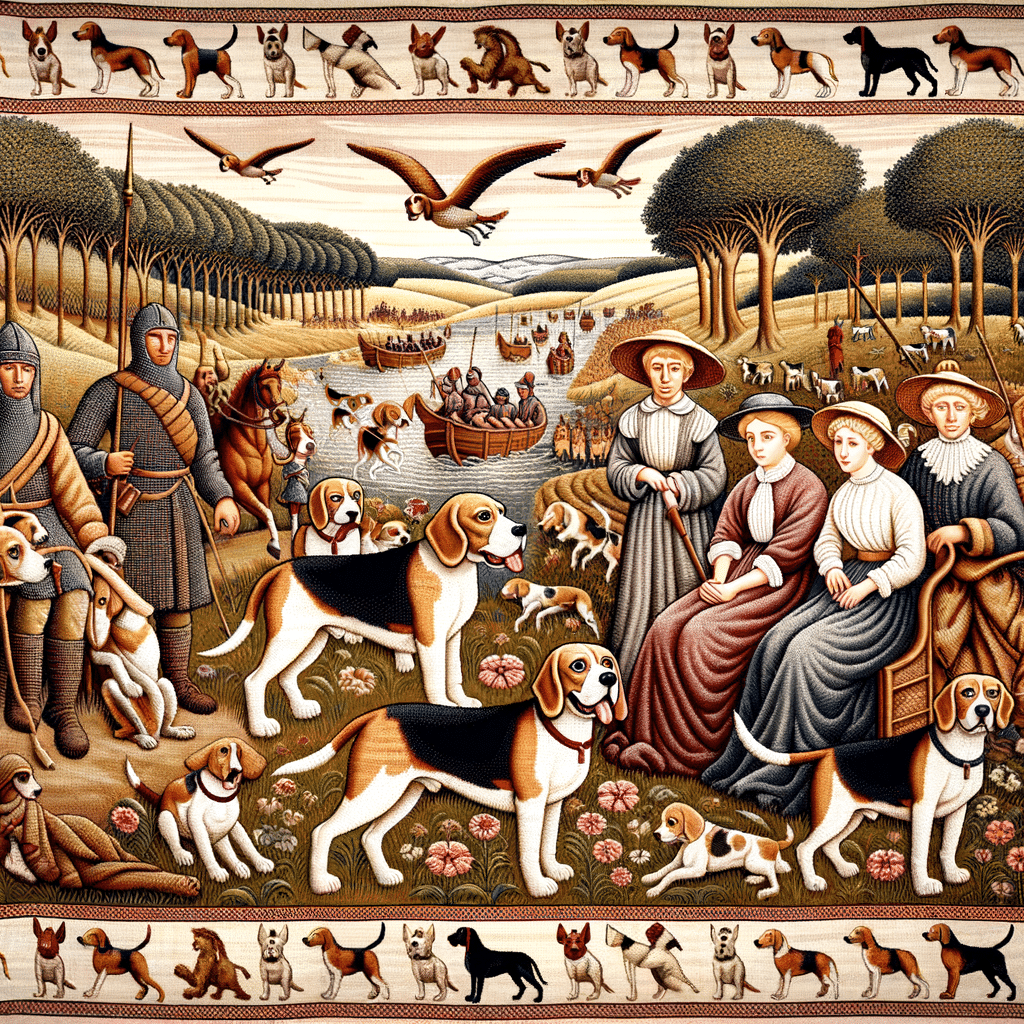The miniature beagle, also known as a pocket beagle, is the diminutive cousin to the well-loved beagle breed. Characterized by their smaller stature, these dogs have become increasingly popular with pet parents, seeking all the personality traits of a standard beagle in a more compact size. While the breed standard for full-grown beagles typically stands about 13 to 15 inches tall with a weight between 20 to 30 pounds, the miniature beagle is usually roughly half that size, making it a convenient option for smaller living spaces and those who might find managing a smaller dog easier.
In This Article
Historically, miniature beagles aren’t a new concept. They date back to the 15th century, when they charmed nobility with their petite size, which, according to anecdotes, was small enough to fit in a ‘saddle pocket.’ However, what contemporary breeders offer as a miniature or pocket beagle may differ significantly from those of historic hounds. Unlike their ancestral counterparts bred for hunting purposes, today’s miniature beagles are primarily companions, maintaining the breed’s trademark friendly disposition and sociability on a smaller scale.
Highlights
- Miniature beagles retain the amiable nature of the standard beagle personality in a smaller package.
- These dogs are adapted to fit contemporary pet-parent lifestyles.
- Despite their reduced size, pocket beagles require the same level of care as their larger breed counterparts.
Origins and History of the Miniature Beagle
The miniature beagle, a compact version of the standard, boasts a rich history steeped in English hunting tradition. This breed emerged as an adept hunting companion, prized for its size and agility in rabbit and hare pursuits.
Historical Background
Hounds similar to miniature beagles have been present in England since before the Roman occupation, tracing back to the use of small pack-hounds in hunting. The beagle’s ancestors were bred specifically for their diminutive stature and hunting prowess. Over the centuries, this scent hound breed evolved into the breed known today as the beagle. This small dog variety has a smaller breed standard, but the pocket beagle temperament resembles their larger scent hound relatives.
Elizabeth I’s Influence
Queen Elizabeth I had a notable impact on the breed’s history, as she favored a type of beagle small enough to fit in a hunter’s glove. Called the “glove beagle,” this tiny version was highly esteemed in the royal courts. Although the glove beagle is now extinct, its legacy contributed to the development of the modern-day miniature beagle. The breed’s size and scent abilities led to its role as a hunting companion, offering company and assistance to hunters who pursued games such as rabbits.
Breed Characteristics and Appearance
The miniature beagle is a compact version of the standard beagle, mirroring its larger counterpart’s appeal in a smaller form factor. This breed is distinguished by its proportionate build and expressive features, which resonate with dog enthusiasts.
Size and Weight
Miniature beagle:
- Height: Approximately Under 13 inches tall at the shoulder
- Weight: Typically ranges between 7-15 pounds
This smaller stature classifies the miniature beagle as a convenient size for those who prefer a smaller, more manageable hound.
Coat and Color Patterns
A miniature beagle’s coat is similar to its larger counterpart. It is short and sleek and requires very little maintenance. Brush your pocket beagle regularly to help maintain their healthy coat.
Colors:
- Commonly found in tricolor (black, brown, and white)
- Red and white
- Lemon
- Fully single-colored coats such as red, tan, or black
The coat of the miniature beagle is easy to care for, making it a suitable pet for owners who seek minimal grooming responsibilities.
Distinguishing Features
The miniature beagle’s appearance is characterized by large eyes with a soft, pleading expression and long, drooping ears framing the face. Their muscular but miniature foxhound-like appearance also distinguishes them.
While not typically prone to tons of genetic health problems, prospective owners should be aware of potential issues like hip dysplasia, which is common in many breeds and can be exacerbated by improper breeding practices. Responsible breeding efforts are crucial to minimize the risk of such health problems.
Temperament and Behavioral Traits
Miniature beagles, known for their compact size and generous nature, manifest a blend of temperament and behavioral characteristics highly favorable for family integration. These traits underscore their desirability as companion pets.
Social and Playful Nature
Miniature beagles are inherently social creatures with a playful streak that makes them excellent companions. They thrive on engaging with both humans and other dogs. Their sweet disposition is a hallmark, often making them well-suited to households with children and other pets.
Intelligence and Trainability
While miniature beagles are recognized for their intelligence, they sometimes display a hint of stubbornness, which can present challenges during training. However, their eagerness to please and quick learning abilities suggest that they tend to be easy to train with consistent and patient training. They respond best to positive reinforcement techniques.
Behavioral Tendencies
When considering behavioral tendencies, it’s important to acknowledge that miniature beagles may exhibit a strong instinct to follow scents, given the beagle’s personality. They often benefit from early training to address unwanted chasing or wandering behaviors. Their energetic and curious personality may require adequate exercise and mental stimulation to avoid boredom-induced mischief.
Care and Beagle Health Considerations
When ensuring a miniature beagle’s health, owners must focus on a balanced diet, regular exercise, consistent grooming, and awareness of potential breed-specific health issues. Beagles also have floppy ears, which make them prone to ear infections. Taking these steps will help maintain a miniature beagle’s overall well-being.
Diet and Exercise Needs
Miniature beagles require a diet rich in nutrients and appropriately portioned to prevent obesity, a common issue in the breed.
Miniature beagles typically thrive on:
- High-quality dog food: Commercially manufactured or home-prepared based on your veterinarian's recommendations.
- Controlled portions: Avoid free-feeding; measure meals to maintain a healthy weight.
For exercise, miniature beagles need:
- Daily physical activity: At least 30 minutes to an hour of exercise, such as walks or playtime, to support their energetic nature.
- Mental stimulation: Interactive toys and games to keep their mind sharp and engaged.
Grooming and Shedding
Grooming a miniature beagle is relatively straightforward but essential.
- Regular brushing: At least once a week to manage shedding and keep their coat clean.
- Bathing: Occasional baths when they get dirty, with a dog-specific shampoo.
Shedding is moderate and can be controlled through regular grooming.
Health Screening and Issues
Regular veterinary check-ups are crucial for monitoring a miniature beagle’s health.
Owners should discuss the following with their veterinarian:
- Health screenings: Regular screenings for conditions like hip dysplasia, hypothyroidism, and certain types of cancer.
- Signs to watch for: Unusual changes in behavior or appetite, as these may indicate health issues.
Owners should also be aware of common health conditions such as:
- Ear infections: Due to their long, floppy ears, which can trap moisture and debris.
- Dental problems: Regular dental cleanings and check-ups are vital.
By adhering to these care and health considerations, owners can help promote the longevity and happiness of their miniature beagle.
Frequently Asked Questions
Exploring the traits of fully-grown miniature beagles unveils their distinct size, cost, and lifespan characteristics, which are essential for potential owners to understand.
What is the typical weight of a fully-grown miniature beagle?
A mature miniature beagle, also known as a pocket beagle, typically weighs between 7 and 15 pounds.
How much can one expect to pay for a miniature or pocket beagle?
The price for a miniature or pocket beagle can vary. Still, prospective owners should expect to pay several hundred to over a thousand dollars, depending on the breeder and the dog’s lineage.
What is the average lifespan of pocket beagles?
Pocket beagles have an average lifespan of 12 to 15 years, with sufficient care and nutrition.






